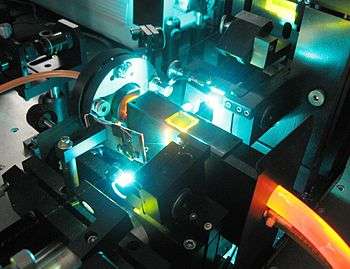Rhodamine 6G
 | |
| Names | |
|---|---|
| Other names
Rhodamine 590, R6G, Rh6G, C.I. Pigment Red 81, C.I. Pigment Red 169, Basic Rhodamine Yellow , C.I. 45160 | |
| Identifiers | |
| 989-38-8 | |
| ChEMBL | ChEMBL1185241 ChEMBL402140 |
| ChemSpider | 16736263 |
| ECHA InfoCard | 100.012.350 |
| KEGG | C11177 |
| |
| Properties | |
| C28H31N2O3Cl | |
| Molar mass | 479.02 g/mol |
| Appearance | dark reddish purple, brown or black crystalline solid |
| Density | 1.26 g/cm3 |
| 20 g/l (25 °C) | |
| Solubility in methanol | 400 g/l |
| Hazards | |
| Safety data sheet | External MSDS |
| Except where otherwise noted, data are given for materials in their standard state (at 25 °C [77 °F], 100 kPa). | |
| | |
| Infobox references | |
Rhodamine 6G /ˈroʊdəmiːn/ is a highly fluorescent rhodamine family dye. It is often used as a tracer dye within water to determine the rate and direction of flow and transport. Rhodamine dyes fluoresce and can thus be detected easily and inexpensively with instruments called fluorometers. Rhodamine dyes are used extensively in biotechnology applications such as fluorescence microscopy, flow cytometry, fluorescence correlation spectroscopy and ELISA.

Rhodamine 6G is also used as a laser dye, or gain medium, in dye lasers,[1][2] and is pumped by the 2nd (532 nm) harmonic from an Nd:YAG laser or nitrogen laser. The dye has a remarkably high photostability, high fluorescence quantum yield (0.95[3]), low cost, and its lasing range has close proximity to its absorption maximum (approximately 530 nm). The lasing range of the dye is 555 to 585 nm with a maximum at 566 nm.[4]
Rhodamine 6G usually comes in three different forms. Rhodamine 6G chloride is a bronze/red powder with the chemical formula C27H29ClN2O3. Although highly soluble, this formulation is very corrosive to all metals except stainless steel. Other formulations are less soluble, but also less corrosive. Rhodamine 6G perchlorate (C27H29ClN2O7) comes in the form of red crystals, while rhodamine 6G tetrafluoroborate (C27H29BF4N2O3) appears as maroon crystals.[5]
Solubility
Butanol (40 g/l), Ethanol (80), Methanol (400), Propanol (15), MEG (50), DEG ( 100), TEG (100), Isopropanol (15), Ethoxyethanol (25), Methoxyethanol (50), Dipropylene glycol (30), PEG (20).[6]
See also
References
- ↑ F. P. Schäfer (Ed.), Dye Lasers, 3rd Ed. (Springer-Verlag, Berlin, 1990).
- ↑ F. J. Duarte and L. W. Hillman (Eds.), Dye Laser Principles (Academic, New York, 1990).
- ↑ R. F. Kubin and A. N. Fletcher, "Fluorescence quantum yields of some rhodamine dyes." J. Luminescence 27 (1982) 455
- ↑ Rhodamine 6G
- ↑ http://www.exciton.com/pdfs/RH590.pdf
- ↑ RHODAMINE 6G